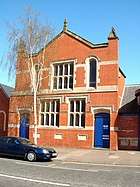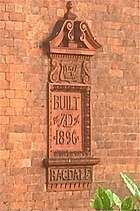John Henry Cooper
John Henry Cooper (c. 1855 – 19 November 1910) was an architect who worked in Lincoln, Lincolnshire. Initially he worked for the Lincoln architect Henry Goddard[1], but had set up his own practice by 1888.[2] He designed shops, chapels and houses in Lincoln and Lincolnshire and he was surveyor to the Lincoln Co-operative Society.
John Henry Cooper | |
|---|---|
.jpg) The Co-operative Sub-Central stores, | |
| Born | c.1855 |
| Died | 19 November 1910 Lincoln |
| Nationality | English |
| Occupation | Architect |
| Buildings | South Bar Congregational Church, High Street, Lincoln 1902 |
Career, practice and family
Cooper worked from Eastwick, Lindum Hill, Lincoln. He was described as "architect and surveyor" and was also an agent for the Sun Life Fire and Insurance Company.[3]The Lincoln architect Fred Baker worked as his assistant from 1897-1900. He married Sarah Fermidge Gresham at St Peter at Gowts Church, Lincoln on 29 September 1878. [4] He died in Lincoln on Monday 14 November 1910 [5]
Architectural work
Methodist & Congregational Churches and Chapels
- Monks Road Congregational Church, Lincoln.

The former South Bar Congregational Church, 1901
- South Bar Congregational Church and School Buildings, High Street, Lincoln. (1901). Cooper advertised for tenders for building work in August 1901. [6][7]
- Wesleyan Chapel, Rowston, Lincolnshire. (1901) [8]
- Primitive Methodist Chapel Croft Street, Lincoln. (1904)[11]
Shops and bank
- Lincoln and Lindsey Bank, 8 Market Place, Spalding. New Bank and alterations to existing building.[12]
- The Co-operative Sub-Central Store, 137-141 High Street Linncoln. 1893. An early department store. The building was sold by the Lincoln Co-operative Society in November 1971. The building was opened in September 1893 and described as follows ‘’Central Store. The building, which consists of three commodious shops and extensive warehouses, is of red brick with stone dressings, and a terra cotta parapet I tearing the name of the Society and a coat of arms. The windows are fitted with plate glass, and the walls in tlie interior of the shops are covered with varnished red deal boarding. From the centre shop there is a capital approach by means of a broad flight of stairs to the upper and the cellering beneath the shop, which are splendidly lighted by means of pavement lights, will be used for storage. The building is admirably arranged, and no expense has been spared in necessary fittings suitable for such an establishment.’’[13]
- 62 and 63 High Street, Lincoln. Erection of a new Pawnbroker’s shop for Frederick Choice. [14]
Houses

15/17, The Avenue, Lincoln 1896

Ragdale, 15 The Avenue, Lincoln. Monogram of W G Henton
- 15 & 17 The Avenue, Double villa house built in red brick with three side bay windows at the corners with decorative terracotta panels. Doorways with terracotta surrounds on street frontage and on south side with terracotta date panel on frontage of no 11, "Ragdale 1896". Built for W G Henton, his initials forming the monogram above the date panel.
- 181-185 Carholme Road, Lincoln.
- 83-89 Hewson Road, Lincoln
- 9-27 Bargate, Lincoln
- House in Stonefield Avenue, Lincoln for John Swan (1895). In Arts and Craft Style. [15]
- 5-12 St Giles Avenue, Lincoln. Built for Joseph Ruston[16]
gollark: I mostly want the fusion reactor and big induction matrix.
gollark: So can you.
gollark: Also, the problem isn't knowing what I had, the problem is actually building it.
gollark: I can't because I'm on my phone.
gollark: Anyway, you get to fix whatever you wrecked.
References
- Obituary notice: Boston Guardian - Saturday 19 November 1910 pg 4.
- City of Lincoln Building applications no.1837
- White’s Lincolnshire Diretory, (1896), pg. 367.
- Lincolnshire Chronicle, Friday 4 October 1878, page 5
- Obituary notice: Boston Guardian - Saturday 19 November 1910 pg 4.
- Lincolnshire Echo - Thursday 15 August 1901, pg. 1
- Lincoln City building applications no. 3494, 17/07/1901
- Lincolnshire Chronicle - Tuesday 21 May 1901, pg.2
- Lincolnshire Chronicle - Friday 3 July 1903, pg 8
- Lincoln City Building applications, no.3789 18/06/1903
- Stamford Mercury - Friday 3 June 1904 pg 5.
- Lincolnshire Echo - Wednesday 25 April 1900, pg.1
- Lincolnshire Echo - Tuesday 19 September 1893, pg. 2
- Lincolnshire Echo - Saturday 30 September 1899
- Lincolnshire Echo - Tuesday 2 July 1895
- Lincolnshire Chronicle - Friday 23 August 1895,pg 5
This article is issued from Wikipedia. The text is licensed under Creative Commons - Attribution - Sharealike. Additional terms may apply for the media files.